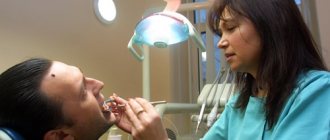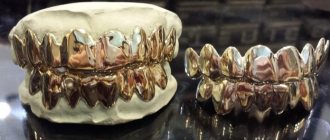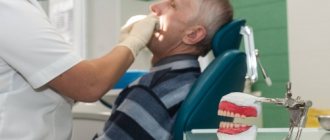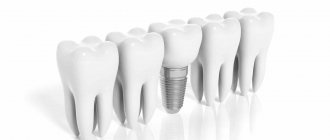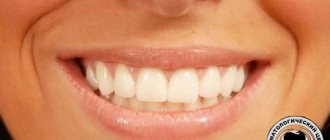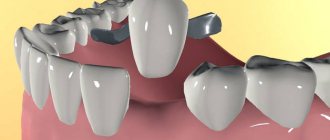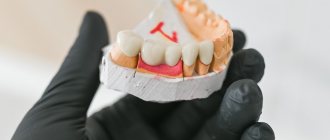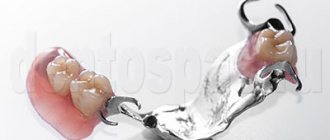Preparing teeth for prosthetics begins with an examination by an orthopedic dentist. It determines the scope and list of measures that will be required to effectively restore the integrity of the dentition.
The basis of preparation is accurate diagnosis. The condition of both jaws can be assessed using a panoramic X-ray - orthopantomogram. It allows:
- see the condition of all teeth;
- assess the condition, volume, structure of the bone tissue of the jaws;
- identify diseases that may interfere with prosthetics (periodontitis, root cysts, etc.);
- determine the condition of soft tissues, the depth of periodontal pockets with periodontal disease, etc.
Based on the diagnostic results, the doctor determines what preparation measures will be required.
Therapeutic preparation
Therapeutic preparation is necessary for the purpose of sanitation of the oral cavity. First of all, professional teeth cleaning is carried out:
- removal of hard dental deposits using ultrasound, less often - mechanical cleaning;
- removing soft plaque using the Air Flow method;
- polishing, fluoridation (remineralizing therapy).
Preparing teeth for prosthetics includes mandatory removal of foci of infection and inflammation. Treatment of caries and complications in the form of pulpitis, periodontitis is carried out, and therapy for inflammatory diseases of the gums and soft tissues of the oral cavity (periodontitis, gingivitis, glossitis, etc.) is prescribed.
Therapeutic preparation also includes removal of the pulp of teeth to be replaced. Afterwards, endodontic treatment is carried out - treatment and filling of the root canals.
Why is it necessary to depulp teeth under metal-ceramics?
This question is very often asked by patients at the stage of preparation for metal-ceramic prosthetics . The name of this design makes it clear that it is based on metal, on top of which ceramic coating is applied, after which the prosthesis is fired in a special oven - this procedure ensures the strength of the connection between metal and ceramics. In order to ensure that after installation of the prosthesis it does not overestimate the bite and does not cause discomfort, it is necessary to create space; for this purpose, the supports are pre-prepared, removing the required amount of enamel and dentin. Thus, the layer of tissue protecting the pulp becomes much thinner. This often leads to so-called postoperative pain, increased sensitivity and the possible development of traumatic pulpitis, since the nervous tissue is highly sensitive. If, some time after installing the prosthesis, the tooth under the crown suddenly begins to hurt and become inflamed, then the entire structure will have to be removed, the resulting inflammation treated , and starting all over again.
Date of publication: September 20, 2020 Last update: September 22, 2022 © 2020 Professorial Dentistry “22 Century”. All rights reserved.
Surgical preparation
Surgical preparation involves the removal of teeth that cannot be treated. For example, highly mobile ones, having a large root cyst, granulating periodontitis, etc.
Osteophytes and exostoses, if present, are also removed. They are outgrowths of bone tissue and can interfere with the installation of a denture.
Surgical preparation of teeth for prosthetics may also include removal of excess soft tissue due to hypertrophy of the mucous membranes and gums.
Implant placement also refers to surgical preparation. Osteoplastic surgery, the implantation of artificial or natural bone tissue to achieve the required volume of bone in the jaw, can also be used as a preliminary stage. One of the types of such an operation is a sinus lift, raising the bottom of the maxillary sinus.
How is prosthetics performed?
Once the oral cavity is prepared, the prosthetic process can begin. It consists of several stages:
- Preparation of teeth that will be involved in prosthetics: depulpation, removal of excess tissue.
- Taking impressions for subsequent production of a jaw model. Also, instead of impressions, intraoral photography can be used, followed by the formation of a three-dimensional digital model of the jaws.
- Design and manufacture of prosthesis.
- Fitting.
- Installation on permanent cement.
Orthopedic training
Orthopedic preparation involves attention to secondary tooth deformations after removal of those located nearby or “antagonist” (located on the opposite jaw) teeth. It involves creating special plates and trays to move protruding teeth to create space for dentures on the opposite jaw. It may also be necessary to make special trays to relieve the masticatory muscles. This is necessary for bruxism and increased muscle tone to prevent damage to structures.
Preparing teeth for prosthetics is a whole range of measures that are designed to prevent the difficulties of wearing artificial structures and are necessary to ensure oral health.
ORTHODONTIC STAGE
At this stage, if necessary, the following problems can be corrected:
- Forms of dentition;
- Positions of abutment teeth;
- Inclination of teeth in relation to missing teeth;
- Fan-shaped position of teeth;
- Pulling out impacted teeth that can become a support for a denture.
During the orthodontic stage, the specialist focuses on secondary deformations of the remaining teeth, if the patient’s neighboring teeth or antagonist teeth were previously removed. Preparation for prosthetics at this stage takes from 2-3 months to 2-3 years.
Prosthetics on implants
Preparatory work includes all necessary procedures. After this, in a two-stage protocol, they wait for the implants to take root, then make impressions and make dentures according to the general scheme.
With a one-stage protocol, the installation of temporary structures is provided immediately after implantation. After about a year, permanent dentures are made and installed. Prices for implant prosthetics may be higher, but the designs last longer and are more reliable, which makes the cost not as high as it seems at first glance.
At the ROOTT ICDC in Moscow, they carry out the entire range of preparatory measures for prosthetics. Our own laboratory, therapeutic, surgical, and orthopedic departments guarantee coordinated work of doctors and excellent results.
Expert of the article Alekperov Roman Borisovich Dentist-orthopedist, doctor of the first category
Work experience 24 years.
Prices for implantation using templates in Moscow
| Consultation with an orthopedist | FOR FREE |
| Installation of 1 implant | 20,000 rub. |
| Implant INNO, South Korea | 10,000 rub. |
| Implant MIS, Israel | 10,000 rub. |
| Implant NOBEL, Sweden | 35,000 rub. |
| Partial removable denture | 15,000 rub. |
| Complete removable denture | 20,500 rub. |
| Clasp prosthesis | RUB 25,500 |
| Ceramic crown | 21,000 rub. |
| Metal-ceramic crown | 5,100 rub. |
Financial issue
With extensive dental prosthetics, when the patient faces a fairly long treatment in several stages, for some people, and especially for pensioners, the issue of the cost of prosthetics arises.
Staged payment without increasing the price
A large amount of work on prosthetics often requires considerable funds; not all people can pay a large bill at a time.
Sometimes it happens that the patient cannot pay the entire bill at once, in one payment.
In such cases, the Lyubertsy Dental Clinic VUGI may offer the patient to split the bill into several payments during the production of the required orthopedic structure (14-30 days);
Preparation for prosthetics for implantation
If implants are chosen as a support for the crown, the preparation of the oral cavity for prosthetics is the implantation itself and additional surgical operations for its implementation, such as bone grafting, sinus lifting, etc. The entire complex of measures for the implantation of artificial roots is carried out according to a high-precision digital protocol:
- CT and 3 D scanning of the jaws . Using computed tomography and intraoral scanning, a three-dimensional virtual model of the jaws is created, depicting the condition of the oral cavity with high accuracy and detail.
- Modeling of future crowns . The future orthopedic design is modeled digitally and the position and shape of the teeth are selected.
- Virtual placement of implants . The location of the implants is determined according to the virtual model of the jaw, taking into account future crowns, bone volume, localization of the facial nerves and other features.
- Making a surgical template . Based on a digital impression of the patient’s jaw, a real projection is made in the form of a positioning mouthguard, with the help of which it becomes possible to accurately comply with the selected conditions for the placement of the implant at the time of surgery.
- Implantation . Depending on the clinical situation, either classical two-stage implantation or implantation according to a one-stage and/or one-stage protocol is performed. After this, the process of osseointegration—engraftment of the implant into the bone—begins.
The long preparatory stage ends with permanent prosthetics - installation of a crown on an implant, usually screw-fixed. As a result of correctly performed implantation, the patient receives a flawless smile without any risks or complications.
Preparatory treatment planning
The orthopedic dentist, together with his colleagues, other specialists, therapist and surgeon, plans to conduct the process of preparing the patient for prosthetics with precision down to the day.
After the preparatory and further treatment plan is ready, the patient’s schedule of visits to the clinic is clarified, dates and times are agreed upon, from what time to what time the patient should be in the clinic, based on the planned medical activities and his time capabilities.
When all the details are agreed upon, the full cost of treatment is also discussed in detail.
Advantages and disadvantages of metal ceramics
Compliance with manufacturing standards and installation technology almost completely eliminates possible harm from installing the structure. The use of modern materials eliminates the release of toxic substances, but it is important to remember that an individual reaction may occur.
The ceramics itself, used in the manufacture of artificial teeth, does not cause allergies - a possible reaction is provoked by the metals in the frame of the structure. For example, chromium-nickel alloys can provoke an allergic reaction to nickel, and the use of base metals under the influence of saliva can be susceptible to oxidation reactions. Symptoms of an allergic reaction may include:
- burning in the mouth;
- metallic taste;
- swelling of the gums in the area of contact of soft tissues with the crown.
If such symptoms occur, it is important to consult a dentist - you will probably need to replace the structure with an all-ceramic crown or use another prosthetic method.
Other disadvantages include the possibility of exposing the metal frame in the event of receding gums. It is worth noting that structures made of zirconium dioxide are not subject to this phenomenon. In addition, the technology of metal-ceramic dental prosthetics involves grinding the tooth under a crown and removing the pulp in many cases, which is also a disadvantage.
The advantages of metal ceramics include high strength and long service life. Today, metal-ceramics are used for both single crowns and bridges - it is in demand when it is necessary to replace teeth with a significant chewing load. The frame made of aluminum dioxide or zirconium is strong enough, so the dentures can withstand heavy loads.
A long service life - 10-12 years for alloys of base metals and about 15 in the case of using a gold-platinum alloy - is a key advantage of the designs. This is only relevant for those prostheses that are made using individual casts. It is also important to follow the doctor’s recommendations for care - in this case, the prosthesis will last as long as it should. This is necessary because one of the common reasons for premature crown removal is the development of secondary caries at the junction of natural and artificial tissues, so it is very important to visit a doctor in a timely manner.
To summarize, we can say that the advantages of metal ceramics are as follows:
- comfort of wearing structures;
- functionality - function is restored due to the flawless modeling of masticatory hillocks;
- strength;
- long service life;
- acceptable aesthetics;
- biological compatibility - in the absence of allergic reactions to metals;
- the possibility of prosthetics for both anterior and chewing teeth;
- shade fastness - ceramics are not susceptible to the action of dyes;
- comparative cheapness;
- the possibility of restoring the structure without removing it in the event of minor chips.

